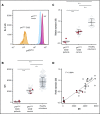NCF1 (p47phox)-deficient chronic granulomatous disease: comprehensive genetic and flow cytometric analysis
- PMID: 30651282
- PMCID: PMC6341190
- DOI: 10.1182/bloodadvances.2018023184
NCF1 (p47phox)-deficient chronic granulomatous disease: comprehensive genetic and flow cytometric analysis
Abstract
Mutations in NCF1 (p47phox) cause autosomal recessive chronic granulomatous disease (CGD) with abnormal dihydrorhodamine (DHR) assay and absent p47phox protein. Genetic identification of NCF1 mutations is complicated by adjacent highly conserved (>98%) pseudogenes (NCF1B and NCF1C). NCF1 has GTGT at the start of exon 2, whereas the pseudogenes each delete 1 GT (ΔGT). In p47phox CGD, the most common mutation is ΔGT in NCF1 (c.75_76delGT; p.Tyr26fsX26). Sequence homology between NCF1 and its pseudogenes precludes reliable use of standard Sanger sequencing for NCF1 mutations and for confirming carrier status. We first established by flow cytometry that neutrophils from p47phox CGD patients had negligible p47phox expression, whereas those from p47phox CGD carriers had ∼60% of normal p47phox expression, independent of the specific mutation in NCF1 We developed a droplet digital polymerase chain reaction (ddPCR) with 2 distinct probes, recognizing either the wild-type GTGT sequence or the ΔGT sequence. A second ddPCR established copy number by comparison with the single-copy telomerase reverse transcriptase gene, TERT We showed that 84% of p47phox CGD patients were homozygous for ΔGT NCF1 The ddPCR assay also enabled determination of carrier status of relatives. Furthermore, only 79.2% of normal volunteers had 2 copies of GTGT per 6 total (NCF1/NCF1B/NCF1C) copies, designated 2/6; 14.7% had 3/6, and 1.6% had 4/6 GTGT copies. In summary, flow cytometry for p47phox expression quickly identifies patients and carriers of p47phox CGD, and genomic ddPCR identifies patients and carriers of ΔGT NCF1, the most common mutation in p47phox CGD.
Conflict of interest statement
Conflict-of-interest disclosure: The authors declare no competing financial interests.
Figures





 production (shaded area, 238.1 ± 108.2 [mean ± 2 SD], n = 922), detected using ferricytochrome c reduction. (B-C) Neutrophils from healthy volunteers were analyzed for p47phox expression. (B) Scatter plots represent neutrophil p47phox expression normalized to cellular actin of 2 healthy volunteers with increased copy number of GTGT (3/6, outlined in red in panel C) comparable to that observed in neutrophils from healthy volunteers with 2/6 GTGT (outlined in green).
production (shaded area, 238.1 ± 108.2 [mean ± 2 SD], n = 922), detected using ferricytochrome c reduction. (B-C) Neutrophils from healthy volunteers were analyzed for p47phox expression. (B) Scatter plots represent neutrophil p47phox expression normalized to cellular actin of 2 healthy volunteers with increased copy number of GTGT (3/6, outlined in red in panel C) comparable to that observed in neutrophils from healthy volunteers with 2/6 GTGT (outlined in green).


Similar articles
-
Chronic Granulomatous Disease: a Comprehensive Review.Clin Rev Allergy Immunol. 2021 Oct;61(2):101-113. doi: 10.1007/s12016-020-08800-x. Clin Rev Allergy Immunol. 2021. PMID: 32524254 Review.
-
Novel Diagnostic Tool for p47 phox -Deficient Chronic Granulomatous Disease Patient and Carrier Detection.Mol Ther Methods Clin Dev. 2019 Feb 10;13:274-278. doi: 10.1016/j.omtm.2019.02.001. eCollection 2019 Jun 14. Mol Ther Methods Clin Dev. 2019. PMID: 30859112 Free PMC article.
-
Gene-scan method for the recognition of carriers and patients with p47(phox)-deficient autosomal recessive chronic granulomatous disease.Exp Hematol. 2001 Nov;29(11):1319-25. doi: 10.1016/s0301-472x(01)00731-7. Exp Hematol. 2001. PMID: 11698128
-
Targeted Repair of p47-CGD in iPSCs by CRISPR/Cas9: Functional Correction without Cleavage in the Highly Homologous Pseudogenes.Stem Cell Reports. 2019 Oct 8;13(4):590-598. doi: 10.1016/j.stemcr.2019.08.008. Epub 2019 Sep 19. Stem Cell Reports. 2019. PMID: 31543470 Free PMC article.
-
Genetic and biochemical background of chronic granulomatous disease.Arch Immunol Ther Exp (Warsz). 2004 Mar-Apr;52(2):113-20. Arch Immunol Ther Exp (Warsz). 2004. PMID: 15179325 Review.
Cited by
-
Diagnosis of Chronic Granulomatous Disease: Strengths and Challenges in the Genomic Era.J Clin Med. 2024 Jul 29;13(15):4435. doi: 10.3390/jcm13154435. J Clin Med. 2024. PMID: 39124702 Free PMC article. Review.
-
A missense variant in NCF1 is associated with susceptibility to unexplained recurrent spontaneous abortion.Open Life Sci. 2022 Nov 14;17(1):1443-1450. doi: 10.1515/biol-2022-0518. eCollection 2022. Open Life Sci. 2022. PMID: 36448060 Free PMC article.
-
Homozygous variant p. Arg90His in NCF1 is associated with early-onset Interferonopathy: a case report.Pediatr Rheumatol Online J. 2021 Apr 23;19(1):54. doi: 10.1186/s12969-021-00536-y. Pediatr Rheumatol Online J. 2021. PMID: 33892719 Free PMC article.
-
Application of Flow Cytometry in Primary Immunodeficiencies: Experience From India.Front Immunol. 2019 Jun 11;10:1248. doi: 10.3389/fimmu.2019.01248. eCollection 2019. Front Immunol. 2019. PMID: 31244832 Free PMC article. Review.
-
Chronic Granulomatous Disease: a Comprehensive Review.Clin Rev Allergy Immunol. 2021 Oct;61(2):101-113. doi: 10.1007/s12016-020-08800-x. Clin Rev Allergy Immunol. 2021. PMID: 32524254 Review.
References
-
- Berendes H, Bridges RA, Good RA. A fatal granulomatosus of childhood: the clinical study of a new syndrome. Minn Med. 1957;40(5):309-312. - PubMed
-
- Bakri FG, Martel C, Khuri-Bulos N, et al. . First report of clinical, functional, and molecular investigation of chronic granulomatous disease in nine Jordanian families. J Clin Immunol. 2009;29(2):215-230. - PubMed
-
- Fattahi F, Badalzadeh M, Sedighipour L, et al. . Inheritance pattern and clinical aspects of 93 Iranian patients with chronic granulomatous disease. J Clin Immunol. 2011;31(5):792-801. - PubMed
-
- Rawat A, Singh S, Suri D, et al. . Chronic granulomatous disease: two decades of experience from a tertiary care centre in North West India. J Clin Immunol. 2014;34(1):58-67. - PubMed
Publication types
MeSH terms
Substances
Grants and funding
LinkOut - more resources
Full Text Sources
Other Literature Sources
Miscellaneous

